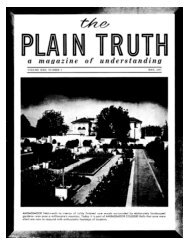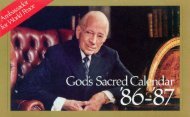The Biblical Basis of the Sacred Calendar Part One
The Biblical Basis of the Sacred Calendar Part One
The Biblical Basis of the Sacred Calendar Part One
You also want an ePaper? Increase the reach of your titles
YUMPU automatically turns print PDFs into web optimized ePapers that Google loves.
We know God entrusted His "oracles" in Hebrew (including <strong>the</strong> commands regarding <strong>the</strong> Sabbath,<br />
Festivals and Holy Days) to <strong>the</strong> Jews. This means that God must also have preserved <strong>the</strong> sacred<br />
calendar through <strong>the</strong> Jews -- despite <strong>the</strong>mselves, if necessary (Romans 3:1-4).<br />
<strong>The</strong> first step in proving this is a comparison <strong>of</strong> <strong>the</strong> principles behind our present sacred calendar with <strong>the</strong><br />
calendrical principles that <strong>the</strong> Bible itself outlines. Once we do this, we may know (<strong>the</strong> Interpreter's<br />
Dictionary <strong>of</strong> <strong>the</strong> Bible and likeminded sources notwithstanding) that <strong>the</strong>re is such a thing in principle as a<br />
"biblical" calendar: in all essentials, <strong>the</strong> same "sacred calendar" that we use today in <strong>the</strong> Church <strong>of</strong> God.<br />
Some Basic <strong>Calendar</strong> Astronomy<br />
<strong>The</strong> biblical calendar (in both its sacred and civil forms) is a lunisolar calendar. It is not based merely on<br />
<strong>the</strong> solar year as is a purely solar calendar (such as our Gregorian calendar), nor merely on <strong>the</strong> lunar<br />
month as is a purely lunar calendar (such as that used by Islam). Ra<strong>the</strong>r, it uses <strong>the</strong> relationship <strong>of</strong> <strong>the</strong><br />
lunar month to <strong>the</strong> solar year as its basis.<br />
In <strong>the</strong> biblical calendar, <strong>the</strong> lunar month and <strong>the</strong> calendrical month are not identical. This is because <strong>the</strong><br />
lunar month is an uneven number <strong>of</strong> days long. Moreover, <strong>the</strong> lunar month varies somewhat in length,<br />
due to <strong>the</strong> "eccentric" (non-circular, elliptical) orbits <strong>of</strong> <strong>the</strong> earth and moon. This means that <strong>the</strong><br />
calendrical month must be ei<strong>the</strong>r 29 or 30 days long -- that is, ei<strong>the</strong>r somewhat less or somewhat more<br />
than <strong>the</strong> length <strong>of</strong> <strong>the</strong> lunar month.<br />
For that matter, in <strong>the</strong> biblical calendar <strong>the</strong> length <strong>of</strong> <strong>the</strong> calendrical year is not <strong>the</strong> same as <strong>the</strong> length <strong>of</strong><br />
<strong>the</strong> solar year. This is because 12 lunar months do not divide evenly into one solar year. A calendrical<br />
year must <strong>the</strong>refore have ei<strong>the</strong>r 12 calendrical months (and thus be shorter than <strong>the</strong> solar year) or 13<br />
calendrical months (and thus be longer than a solar year).<br />
A basic question we need to ask, <strong>the</strong>n, is: When does <strong>the</strong> calendrical "month" (in Hebrew, chodesh or<br />
"renewal") begin in <strong>the</strong> biblical calendar?<br />
In antiquity <strong>the</strong>re were two basic ways <strong>of</strong> reckoning <strong>the</strong> calendrical month. <strong>One</strong> way was to observe <strong>the</strong><br />
phases <strong>of</strong> <strong>the</strong> moon and to mark <strong>the</strong> beginning <strong>of</strong> <strong>the</strong> calendrical month when <strong>the</strong> moon was at a<br />
particular phase -- usually, when <strong>the</strong> moon was first visible as a crescent after sunset. (<strong>The</strong> moon in such<br />
a phase is <strong>of</strong>ten called a "new crescent" or -- borrowing from <strong>the</strong> Greek -- a phasis.) <strong>The</strong> only o<strong>the</strong>r way<br />
was to calculate <strong>the</strong> average length <strong>of</strong> <strong>the</strong> lunar month, and with it <strong>the</strong> mean conjunction (<strong>the</strong> average<br />
time <strong>of</strong> <strong>the</strong> "new moon" or "dark moon" -- in Hebrew, <strong>the</strong> molad), on <strong>the</strong> basis <strong>of</strong> <strong>the</strong> exact timing <strong>of</strong> solar<br />
and especially lunar eclipses as measured over a period <strong>of</strong> years. <strong>The</strong> true conjunction (which may<br />
precede or follow <strong>the</strong> mean conjunction by a number <strong>of</strong> hours) cannot be observed from earth, except<br />
from very restricted geographical locales during total solar eclipses.<br />
<strong>The</strong>se two methods <strong>of</strong> reckoning <strong>the</strong> calendrical month do not give <strong>the</strong> same results month by month,<br />
even if one assumes that <strong>the</strong> calendar day begins at <strong>the</strong> same longitude. Just before <strong>the</strong> fall equinox, <strong>the</strong><br />
new crescent cannot be seen from Jerusalem less than 20 hours after <strong>the</strong> true conjunction (or six hours<br />
after <strong>the</strong> mean conjunction or molad). When <strong>the</strong> crescent appears, it is already at least one calendar day<br />
old,1 or even two or three days old,2 as measured from ei<strong>the</strong>r <strong>the</strong> true or mean conjunction.A calendar<br />
which begins its months with <strong>the</strong> new crescent will set <strong>the</strong> "default position" <strong>of</strong> <strong>the</strong> first day <strong>of</strong> <strong>the</strong> month<br />
one day later than a calendar which begins its months with <strong>the</strong> mean conjunction.<br />
<strong>One</strong> would expect that a culture that called its month a "renewal" (as well as yareach, literally "moon")<br />
would begin its calendrical month with <strong>the</strong> molad, not with <strong>the</strong> phasis.3 <strong>The</strong> astronomical lunar cycle<br />
begins its "renewal" with <strong>the</strong> astronomical new moon or true conjunction, not with <strong>the</strong> new crescent.<br />
Again, <strong>the</strong> sun and moon align with <strong>the</strong> earth at <strong>the</strong> astronomical new moon, not at <strong>the</strong> new crescent.4<br />
However, because <strong>the</strong> astronomical new moon normally cannot be seen from earth (and could not be
















